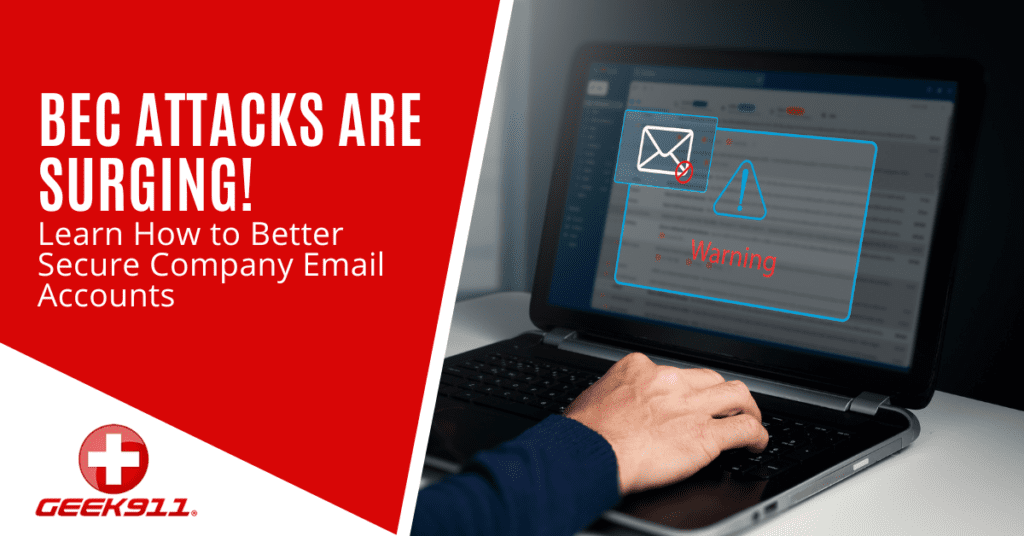BEC Attacks Are Surging! Learn How to Better Secure Company Email Accounts

For a very long time, email has been the fastest, safest, and most effective way for business in almost every industry, from retail to IT, music to agriculture, and real estate to construction, to communicate. This is because it is the most professional communicating platform. However, as email communication continues to grow in popularity and communication and technology, so have the cyber threats and attacks around it.
Recently, email communications have become under attack. To carry out these schemes, attackers spoof domains to make their emails appear from trusted contacts, distribute malware and spam via email channels, and use social engineering to trick users into making payments or logging into fake accounts.
There are so many threats against email communications. However, one particular threat that has been on the rise frequently is Business Email Compromise (BEC), also known as CEO fraud or whaling attacks.
BEC is a cyber-attack that has become businesses’ worst nightmare. According to a report in Statista, during an investigation conducted in the second half of 2020, it was discovered that the most commonly used email provider for BEC attacks was Gmail, accounting for 43% of all business email compromise campaigns.
These attacks can lead to financial and reputational damage to businesses of all sizes. This makes securing your company’s email accounts, as well as other accounts, important.
What Are BEC Attacks About?
Business email compromise (BEC) is the most serious financial threat to corporate cybersecurity in recent times. Formally labeled the Man-in-Man-Email scams, business email compromise attackers rely on employing social engineering tactics to dupe the recipient psychologically. This involves impersonating a key person in a company, such as the CEO or any executive, and engaging in interaction with unsuspecting employees and executives with the authority to make fund transfers.
This strategy is to trick them into believing they are speaking to a legitimate person, then release sensitive information, authorize fraudulent transactions, or other activities that could jeopardize the targeted organization’s security.
BEC fraudsters frequently research their targets and learn about employees’ job titles and email addresses through social media and other online resources. According to a Statista report, 25.6% of BEC scammers pretend to be the CEO of their victim’s company, making them the most impersonating position.
How BEC Attacks work
BEC attacks impersonate key figures in a company and target employees in finance, human resources, and accounting. These attacks are aimed at stealing money or confidential information from businesses. It capitalizes on people’s reliance on email to conduct business.
This attack work by the cybercriminal creating an email account that looks exactly like a company executive. They use this phony account to dupe employees into providing their system credentials, which the attacker then uses to break into the network and steal data.
Here are common tactics on how BEC attacks work:
- Impersonation
The attacker impersonates a legitimate email address or website. They then use the compromised address to impersonate a key executive or entity to trick authorized employees into disclosing sensitive information or transferring money to fraudulent accounts.
- Malware installation
Malware can be installed on a victim’s computer to track their activity, capture keystrokes, or take screenshots. The attacker sends the employee an email containing a file that installs malware on the computer when opened by the recipient. After the installation, malware can be used to steal sensitive information or take control of the employee’s computer.
- Phishing
The attacker sends a phishing email to an employee, typically with a sense of urgency, to trick them into providing sensitive information or credentials. They’re frequently disguised as internal communications from someone within the company (i.e., an executive), with subject lines like “urgent wire transfer” or “urgent invoice” requesting sensitive data right away.
How to Better Secure Company Email from BEC Attacks
Taking the following steps to secure your email will help protect your company from BEC and other forms of cybercrime:
- Enable Multifactor Authentication (MFA) for email accounts.
Passwords alone are insufficient in today’s cyber threat landscape. Instead, users should use Multifactor Authentication (MFA) to add an extra layer of security to their email accounts. When users sign in to their email account with 2FA or MFA, they receive a notification to complete another step in the confirmation process to confirm they are who they claim they are. This procedure ensures that hackers cannot access a user’s account even if they obtain their password.
- Educate your employees to understand BEC attacks
Training your staff about BEC attacks and how to identify phishing emails is one of the most crucial steps you can take to secure your email from BEC. Employees are an organization’s most valuable asset, but they are also its weakest link in terms of cybersecurity. Training your employees to identify phishing emails and respond to suspicious messages is crucial in protecting your company from BEC attacks.
- Redesign your payment processes
BEC fraud is based on tricking a single authorized employee into sending a wire transfer. You can reduce this risk by incorporating redundancy into the payment transfer process. Create a payment approval protocol, for example, requiring a second employee or executive to validate and approve all money transfers. Employees should also be required to confirm money transfers via a secondary communication medium, such as speaking in person or over the phone.
- Set up Email Filters and Blocks
Using email filters and blocks can help prevent suspicious emails from ever reaching employees’ inboxes. Email filters are designed to block emails that contain suspicious attachments or links, as well as emails that originate from suspicious domains. Emails that use common BEC tactics, such as urgent wire transfer requests or payment instructions changes, can also be flagged by filters.
- Implement DMARC Protection
DMARC is a well-known spam-filtering email security protocol. DMARC can detect and prevent threats from various email scams, including BEC attacks.
- Implement strong password
Strong password policies are another important security measure to implement. Passwords should be strong and frequently changed to prevent cybercriminals from accessing a company’s email systems. Use a strong, complex password that combines uppercase and lowercase letters, numbers, and symbols.
- Use Encryption
Encryption is a vital step of any cybersecurity strategy. Encrypted emails jumble your messages, making them impossible to decipher if intercepted by a criminal. Encrypting company email with specialized email security software is an excellent way to keep hackers at bay.
Secure Your Email Account Today
GEEK911 acts as an extension to your business, assisting you to keep your business IT resources productive by ensuring effective equipment upgrades and training your employees on the best practices to protect their email accounts.
If you need assistance in securing your business email accounts, you can reach GEEK911 via 1-866-433-5411 or send us a message.
